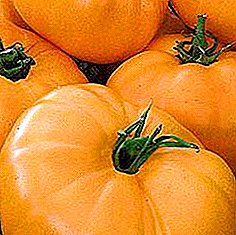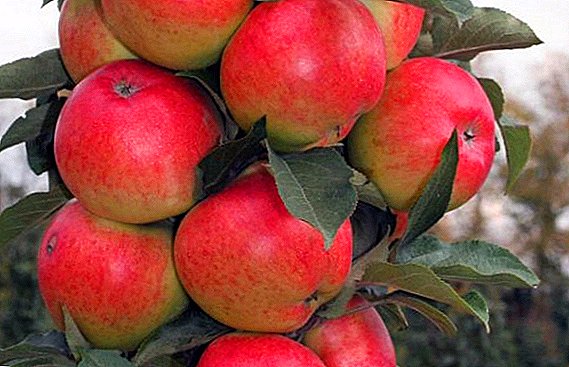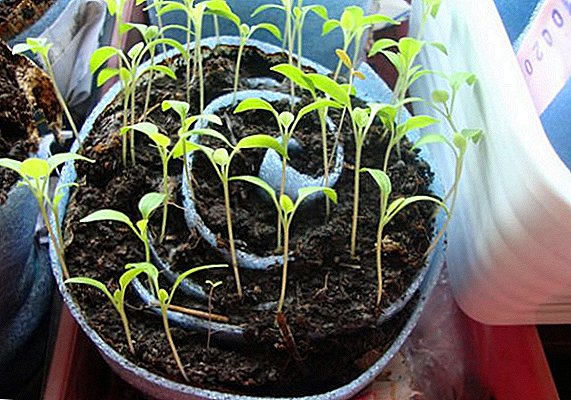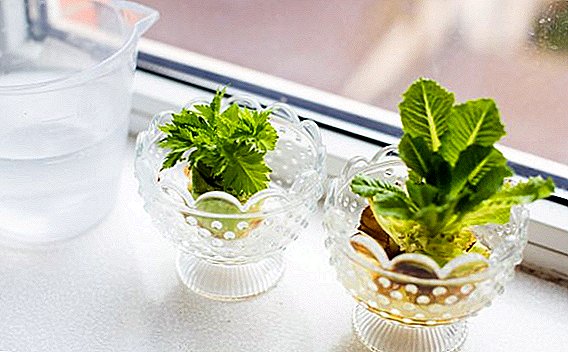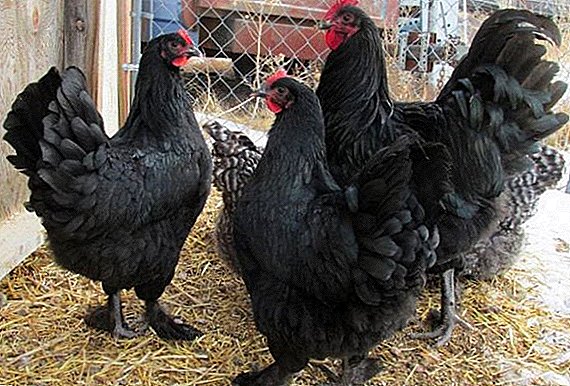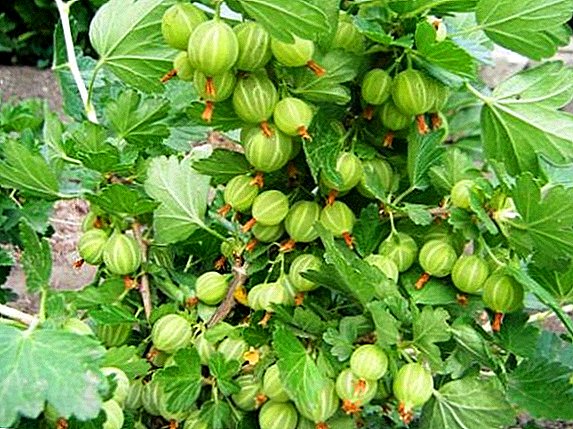 The universal use of gooseberry berries in cooking and the benefits derived from their use ensure high popularity of this plant. Harvesting, ever more complicated by injuries from the thorns that thickly cover the bushes, prompted the breeders to develop new varieties of gooseberry with fewer thorns. One of these varieties, not inferior in taste to the usual gooseberries, is the variety "Beryl".
The universal use of gooseberry berries in cooking and the benefits derived from their use ensure high popularity of this plant. Harvesting, ever more complicated by injuries from the thorns that thickly cover the bushes, prompted the breeders to develop new varieties of gooseberry with fewer thorns. One of these varieties, not inferior in taste to the usual gooseberries, is the variety "Beryl".
Inference history
The gooseberry "Beryl" owes its appearance to the harmful fungal disease of the genus Spherotek, referred to as "American powdery mildew". The aspirations of breeders to bring new varieties as a result of crossing European and American varieties that are resistant to fungal diseases, were crowned with success.
A great work started in 1934-1950 by the breeder and senior researcher at the Chelyabinsk Fruit and Vegetable Station named after. I. V. Michurin Alexei Pavlovich Gubenko. The result of this work is the new varieties of gooseberry "Poor-Lame" and "Chelyabinsk Green", with the participation of which further crosses were carried out.
Important! The variety "Beryl" is self-fertile and does not require additional pollination to ensure high yields.

Since 1971, work on the breeding of new varieties continued scientist-breeder for berry crops Vladimir Sergeevich Ilyin.
We recommend to get acquainted with the most popular varieties of gooseberry and the best varieties without thorns.
Under his leadership, such varieties of gooseberry as the "Harlequin", "Beryl", "Dessert", "Emerald", "Commander", "Senator", "Ural emerald", "Ural gem", "Fantasy" and others were bred. The Beryl variety has been included in the State Register of Breeding Achievements since 1998.
Description and characteristics
Gooseberry "Beryl" - a type of perennial shrub plant of the Gooseberry family of the genus Currant. Its biological features are expressed in the characteristics of the bush and berries. 
Shrub
The bush of medium height, reaching a height of not more than 1-1.2 meters, spreading, thick:
- Shoots - medium thick, cylindrical, curved with a flexible overhanging top;
- lateral branches are threefold, the lower part of more mature ones is covered with spikes;
- bark of dark brown color with anthocyanin shades (gray, red, blue, violet, etc.), characteristic for different terms of ripening;
- spikes - weak, single, perpendicular to the direction of growth;
- leaves are green, large, soft, elongated, rounded, three- or five-lobed with deep cuts, do not have pubescence;
- buds - small, elongated oval shape, have a deviation from the shoot;
- flowers are large and voluminous, have bright green or red hues, elongated cupped, placed in pairs in the inflorescence.
Check out the nuances of growing such gooseberry varieties as "Spring", "Honey", "Krasnoslavyansky", "Consul", "Grushenka", "Malachite", "Komandor", "Kolobok".
Berries
Gooseberry fruits are large-sized berries, one-dimensional, with a mass of from 3.9 to 9.2 grams.
Berries characteristic of such a biological description:
- shape - rounded;
- color - light green with contrasting longitudinal veins;
- the skin is thin, strong, without pubescence;
- the pulp is juicy;
- taste - sweet and sour.

The chemical composition of 100 grams of the edible part is represented by the content:
- proteins - 0.88 g;
- fat 0.58 g;
- carbohydrates - 10.18 g;
- dietary fiber - 4.3 g;
- water - 87.87 g.
Did you know? In the Soviet Union, the cultivation of gooseberries was considered uneconomical, and its wide distribution was stopped, replacing it with black currants.
Some features of the variety
Features of the variety "Beryl" are expressed in such characteristics as resistance to diseases, drought and frost resistance, yield and ripening period, the level of transportability, the use of berries in different fields of activity.
Disease and pest resistance
Variety "Beryl" resistant to many diseases and pests, but with the wrong care of the plant, the probability of damage remains high. 
Did you know? Gooseberry due to its chemical composition is useful for use for people with diagnosed diseases of the cardiovascular system, kidney, anemia, as well as with beriberi.
There is a high probability of powdery mildew (spherotek) and downy mildew (peronosporoz). These fungal diseases stop the growth and development of the plant, subsequently without proper treatment leading to its death.  Sphereoteka Signs of illness - the appearance of spots on the shoots and leaves of the bush, which, gradually growing, cover the bush with a dense bloom, as a result of which the leaves dry and fall.
Sphereoteka Signs of illness - the appearance of spots on the shoots and leaves of the bush, which, gradually growing, cover the bush with a dense bloom, as a result of which the leaves dry and fall.
Important! Pest bush is rarely affected.
Of the pests, the most likely attack is the pale-footed sawfly or yellow gooseberry sawfly. The larvae of these insects (caterpillars) appear from eggs laid by butterflies in early spring and eat soft parts of the leaves, completely destroying all the green parts of the plant.
Find out what other diseases and pests affect gooseberries and how to deal with them.
 Pale Legged Sawfly
Pale Legged Sawfly  Yellow gooseberry sawfly
Yellow gooseberry sawfly
Drought resistance and frost resistance
Gooseberry does not tolerate waterlogging, but is highly resistant to drought. Growing up on garden plots, it does not require frequent watering, but it is still not worthwhile to allow a prolonged lack of moisture in hot weather. As for frost resistance, the Beryl variety does not need shelter for the winter season and is able to withstand low temperatures down to -38 ° C.
Ripening period and yield
"Beryl" refers to mid-season varieties, and this means that the ripening of berries occurs in the middle of summer: the first crop can be harvested in mid-July. The yield of the variety is high - one bush is able to produce from 5 to 10 kilograms of berries per season.
Transportability
At the stage of technical maturity (i.e., slightly unripe), the berries retain their freshness for 3 days and can easily be transported. Upon reaching removable maturity (full maturity), the transportability of berries is significantly reduced, which makes it impossible to transport for long distances. 
Use of berries
Gooseberry is a universal berry used in various fields of human activity. Its rich chemical composition and medicinal properties provide application in traditional medicine as the main component of recipes from various diseases.
Also, the properties of the berries are well established in cosmetology, in particular, for the manufacture of masks, scrubs, creams and lotions. The most widely used gooseberry fruit in cooking.
On the basis of berries it is possible to produce:
- alcoholic drinks - liqueurs and liqueurs;
- marinades for additional processing of meat;
- sauces for all sorts of meat dishes;
- desserts - compotes, preserves, jams, confitures;
- dried fruits.
You will certainly be interested in reading about how to make homemade wine, sauce, jam and gooseberry jam, as well as how to pickle gooseberries at home.

Despite such widespread use of gooseberry, for some people, the use of berries can cause complications in the course of such diseases:
- diabetes;
- chronic inflammatory and ulcerative diseases of the gastrointestinal tract;
- kidney and urinary tract.
Important! The presence of chronic diseases requires prior consultation with the doctor about the correct amounts and types of consumption of the fruit of the gooseberry.
How to choose seedlings when buying
Good growth and development of the plant, its future yield depends on the correct choice of seedlings. Preference can be given to both seedlings with an open root system, and container growing.
Video: how to choose the gooseberry seedlings Saplings with an open root system should be at least 2 years old and have 2-3 strong shoots reaching a length of at least 20 cm. Axillary buds should be enlarged, but not yet dissolved, foliage is allowed only on the tips of the shoots.
The root system of saplings must necessarily be developed, lignified, moist. According to a visual assessment, the bark and the shoots of the plant should not be damaged or show any disease.
Saplings with a closed root system do not have a certain age for sale. They must be well developed and completely leafy, the size of the shoots at the same time can reach 40-50 cm. It is important that the root system fills the container and forms a dense earthen clod.
In container development, a healthy and strong sapling should give the maximum number of young white roots, which will be noticeable when transplanting plants. By visual assessment, the bark and shoots of the plant should not have any damage or signs of disease. 
Did you know? During the reign of Peter I, the Italians, who arrived in Russia, called the gooseberry "northern grape" for the sweetness and juiciness of the fruit.
Gooseberry seedlings can be purchased on the market, in the garden center or online store.
Growing conditions
Gooseberry does not belong to unpretentious plants and requires certain conditions for growing. The gooseberry "Beryl" is not particularly picky about the soil composition: loamy, sandy and sandy soils with moderate pH values are suitable for planting and growing.
It will be useful for you to read about how to independently determine the acidity of the soil at the site, as well as how to deoxidize the soil.
Acidic soils are not suitable for cultivation; therefore, in such cases, a preliminary decrease in acidity by adding dolomite flour is recommended. Depending on the composition of the soil, gooseberry requires periodic application of organic and mineral fertilizers.  Does not like gooseberry and close groundwater, as excessive moisture will provoke the appearance of fungal diseases in the plant. "Beryl" is very picky about lighting and prefers to grow in sunny areas, protected from the winds.
Does not like gooseberry and close groundwater, as excessive moisture will provoke the appearance of fungal diseases in the plant. "Beryl" is very picky about lighting and prefers to grow in sunny areas, protected from the winds.
Time and landing scheme
Comfortable for growing gooseberries are the rows of trees growing in sunny and elevated areas - this will contribute to the formation of penumbra acceptable to the bush and will shelter from drafts.
For normal growing season, the best time to plant a seedling is early autumn (late September – early October). There is still a lot of time before the first frost, which will allow the seedling to take root well before the winter season.
Important! For landing it is important that the temperature at night does not fall below 5ºС-10ºС.

To ensure sufficient distance for the future formation of the bush, the landing holes should not be closer than 1.5 meters. The depth and width of the landing holes should be at least 50 cm in width and depth. It is important that this distance be 5 cm larger than the volume of the root system or transshipment lump.
This is explained by the fact that the gooseberry can form additional surface root processes, which in the winter season without ground cover can freeze.
Prepared pits should be fertilized by adding a layer of humus mixed with compost and sand to the bottom. For good rooting, it would also be good to add mineral fertilizers to the bottom (for example, 30 grams of superphosphate and 20 grams of potassium phosphate).
Planting is carried out by the vertical placement of the seedling in the planting pit with a careful distribution of the root system at the bottom. The sapling is covered with soil, constantly tamping up each layer so that voids do not form and the earth tightly covered the root system.
Video: how to plant gooseberries After planting, it is worth cutting off a little, leaving 4-5 growth buds on each branch. At the end of the seedling, it is necessary to shed 1 pail of water abundantly and after the moisture is fully absorbed, the landing site should be mulched with fallen leaves, hay or sawdust.
Basics of seasonal care
For good development and a bountiful harvest, the plant requires care, which consists in periodic watering, soil care and timely fertilization, as well as annual pruning, which gives the gooseberry strength to survive the winter cold.
Watering
Arid and hot summer requires additional soil moisture. This is especially true of such growing periods as flowering, fruit set and crop ripening require.
Important! 2-3 weeks before the harvest, abundant and frequent watering should be avoided, as the taste and quality of the berries decrease from excess moisture.

It is necessary to carry out watering at least once a week, and it is not desirable to moisten the shoots and leaves. Watering is done only in the near-stem circle in the amount of 1 bucket for each bush. If summer is accompanied by frequent rains, additional watering is not required.
Soil care
Prevent disease, the emergence of pests and ensure high productivity of the bush can the proper care of the soil.
It refers to such actions:
- soil loosening - this event must be performed twice a month with careful movements in order to avoid damage to the root system;
- weed removal - it is necessary to make it together with loosening;
- mulching - action should be carried out after each irrigation to preserve moisture in the soil.

Top dressing
Timely application of top dressing will saturate the soil with nutrients necessary for gooseberry development. Annual feeding should be carried out annually in the following sequence:
- In early spring humus is brought under the shrub as mulch.
- At the end of spring, mineral (in the form of ammonium nitrate in the amount of 20 g per 1 sq. M) or organic nitrogen fertilizers (in the form of bird droppings or manure, should be added to the soil in the near-stem circle as water for several days).
- By the end of June, when the flowering of the bush will be at the final stage, it is necessary to apply phosphorus-potassium fertilizers (superphosphate or potassium phosphate) in an amount of 20 g per 1 sq. M. m. for good formation of ovaries.
Important! To ensure a high harvest in the next season, it is impossible to leave the remnants of the current harvest on the branches of the bush.

- In the first half of July, the gooseberry soil can be shed several times with nitrogen-magnesium fertilizer (magnesium nitrate) to increase fruit production (in the amount of 20 g per 10 l of water).
- In the first half of the autumn season, the bush must be fertilized with 30 grams of superphosphate and 20 grams of potassium phosphate to ensure a high level of winter hardiness.
Top dressing according to the scheme will create the most comfortable conditions for good fruiting.
Pruning
The annual pruning will help to avoid excessive overgrowing of bushes and give the right shape. All weak basal shoots, broken branches, as well as those with the slightest signs of the disease can be removed.
We recommend that you familiarize yourself with the methods of cutting gooseberries, as well as when and how to cut gooseberries in the fall.
Pruning can be done in early spring, until bud breaks, or in late autumn, pruning 2/3 of all old branches at soil level. Such an event will rejuvenate the bush and give life to new and strong shoots.
Video: Gooseberry Pruning
Winter cold protection
To protect the plant from freezing will help simple steps. The preparation should begin in late autumn, when the average daily temperature drops below 0 ° C.
At the first stage, the soil under the bush needs to be shed with 5-6 buckets of water to provide a sub-winter moisture charge. At the subsequent stage, the branches of the bush should be bent down to the ground and fixed with pegs, while it is important that the branches do not lie completely on the ground.
The third stage is the mulching of the soil around the plant: the mulch layer should not be less than 7 cm. If the air temperature drops below 15 ° C, the layer can be increased to 20 cm. .
Important! To prevent premature development of the kidneys and their subsequent freezing from late frosts in early spring, all shelters must be removed.

The advantages and disadvantages of the variety
Gooseberry "Beryl" has its advantages and disadvantages.
The advantages of the variety include:
- frost resistance;
- high yield;
- large fruits;
- bright taste of the fruit.
- low resistance of the variety to such diseases as powdery mildew, downy mildew;
- susceptibility to attack by pests such as the pale-footed sawfly and yellow gooseberry sawfly.
Gooseberry is a popular berry, which is of great benefit to the human body. The variety of gooseberry "Beryl" has many advantages in comparison with others and is conditionally unpretentious plant.  The large size and bright taste of the berries provide this variety with high popularity. Moreover, the use of gooseberry berries is diverse and possible in different spheres of human activity.
The large size and bright taste of the berries provide this variety with high popularity. Moreover, the use of gooseberry berries is diverse and possible in different spheres of human activity.
Reviews from the network






